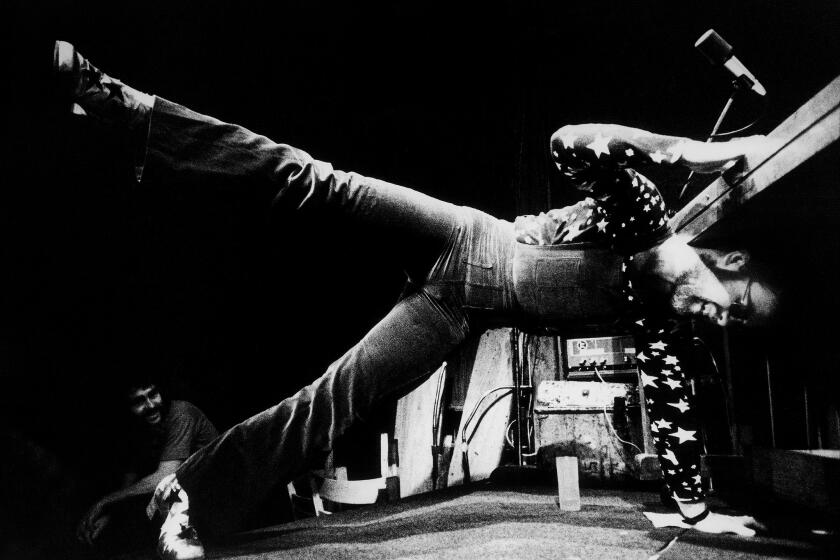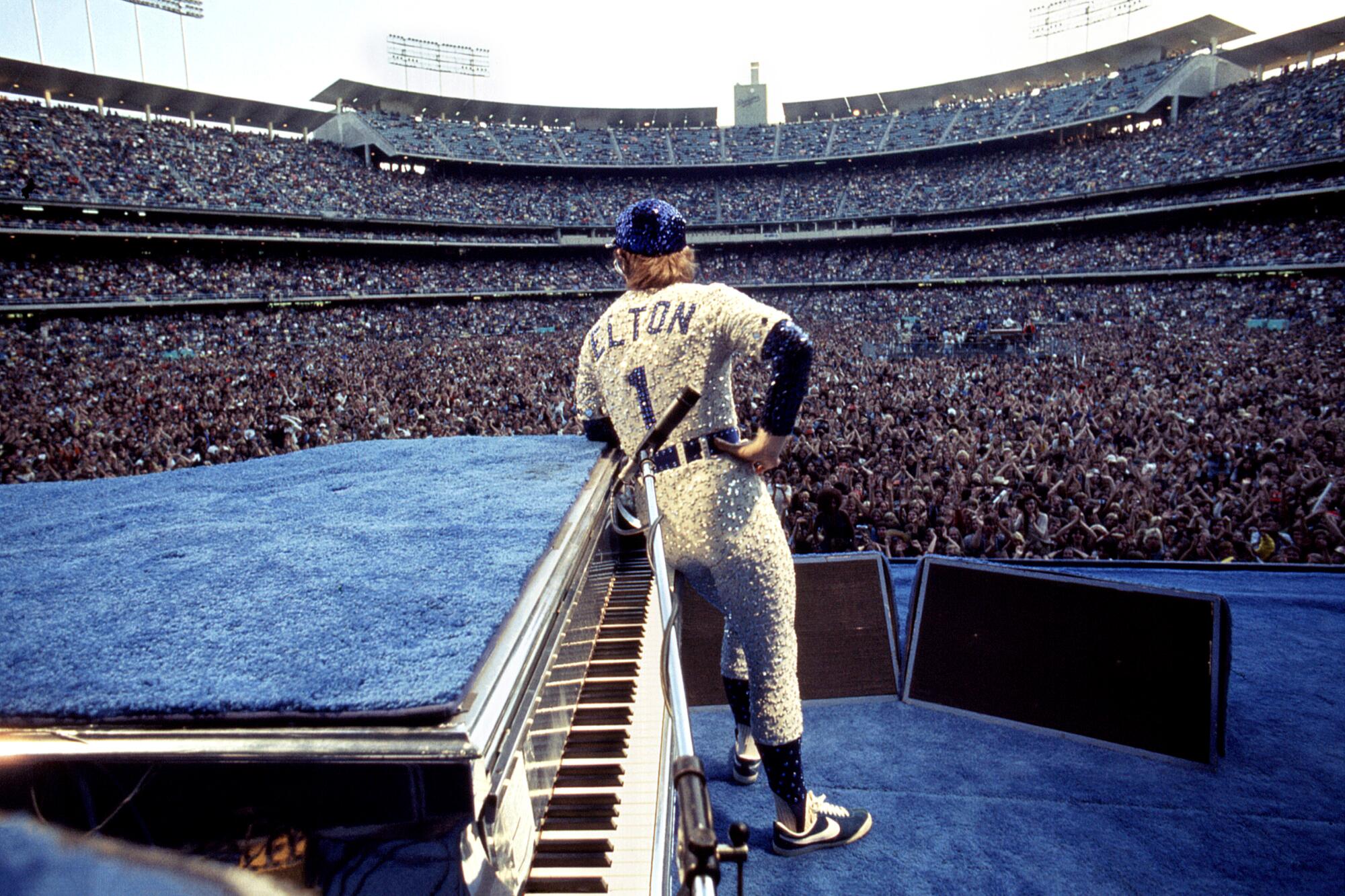
- Share via
In October 1975, Elton John was the biggest pop star in the world. His last two albums, “Captain Fantastic and the Brown Dirt Cowboy” and “Rock of the Westies,” had entered the Billboard album chart at No. 1, a first for any artist. “No one had ever done that before,” he wrote in his 2019 memoir, “Me.” “Not Elvis, not the Beatles.”
At 28, he was about to perform two sold-out shows at Dodger Stadium, where the last concert attraction was said Beatles in 1966. John and his manager/romantic partner, John Reid, had flown their friends and families, along with a British documentary film crew, from London to L.A. to help celebrate this milestone, and all had gathered at John’s secluded Beverly Hills estate the day prior to the Dodger Stadium concert to hobnob, sip champagne and fete the host. “And that,” wrote John, “was when I decided to try and commit suicide again.”
John goes on to say he had no intention of actually killing himself, having swallowed “a load of Valium” and thrown himself in his swimming pool in full view of his guests. His songwriting partner, Bernie Taupin, who was there that day, wholeheartedly agrees. “To be honest,” he writes in an email, ”it wasn’t that big a deal. Just our boy putting on a dramatic show for friends and relatives. He was very good at that!” John was still a year away from publicly revealing his bisexuality, as he framed it, to Rolling Stone, and was in the throes of an addiction trifecta, to drugs, food and sex. If life didn’t come easily to him, writing some of the rock era’s most indelible hit songs and performing them for thousands did. “It was the only time I really felt in control of what I did,” John wrote of playing live. Indeed, “twenty-four hours later I was onstage at Dodger Stadium.” The shows, he concluded with no false modesty, “were a complete triumph.”
This week, 47 years later, John returns to Dodger Stadium to perform three shows, on Nov. 17, 19 and 20, his last-ever U.S. concerts (so he says), as part of his long-running, wildly lucrative Farewell Yellow Brick Road tour. (The show on the 20th will be livestreamed on Disney+.) John, 75, has been sober for decades, and his husband, David Furnish, with whom John has two children, now serves as his manager. The tour kicked off way back in September 2018 and was supposed to run for three years, but COVID had other plans, and so John will head to Australia and then Europe for the final, final farewell shows in 2023, having already raked in well more than $600 million in what has become the third highest-grossing tour in history. In fact, if these Dodger Stadium shows feel like déjà vu, that’s because John already bid L.A. farewell, at the then-Staples Center, in January 2019.
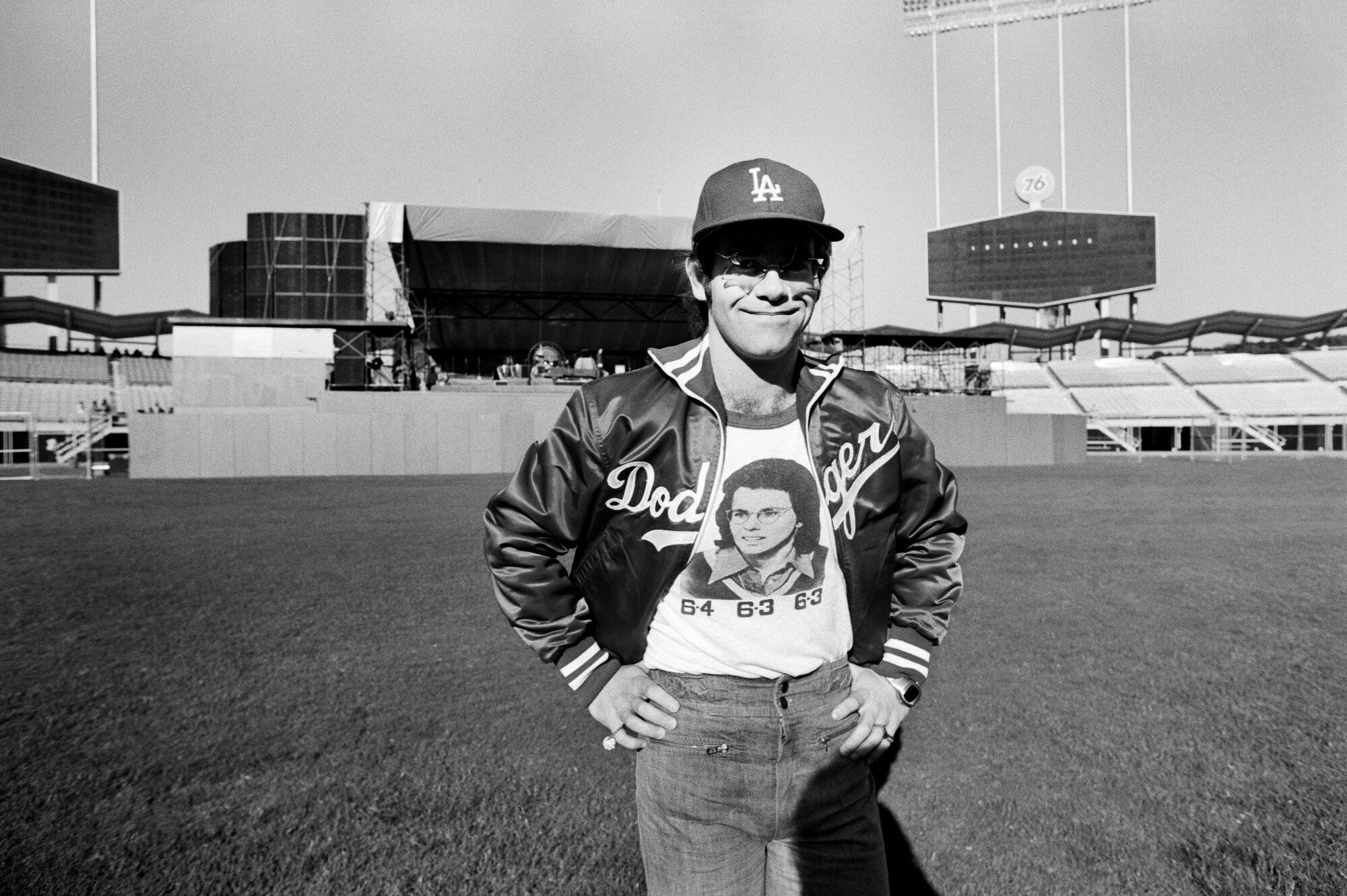
But John and L.A. have always enjoyed a special relationship, starting with the now almost apocryphal shows at the Troubadour nightclub in August 1970. Back in England, John was a skilled, hardworking piano player and tunesmith who had tried for years to gain a foothold in the business, with middling results. Paired by his record label with Americana-obsessed lyricist Bernie Taupin, John was already balding and bespectacled, short of stature and rock-star sex appeal, lacking the alien allure of a David Bowie or the rebel intensity of a John Lennon. But he had songs and gumption, and his American label pulled out all the stops for John’s American debut — Neil Diamond introduced him from stage, and Quincy Jones and one of John’s musical heroes, Leon Russell, were in the audience. More important, so was then-Times pop critic Robert Hilburn, who provided John the kind of rave, career-minting review that music-biopic screenwriters can only dream of as an Act 1 denouement: “Rejoice,” Hilburn exclaimed. “Rock music … has a new star. He’s Elton John … whose debut Tuesday night at the Troubadour was, in almost every way, magnificent.”
“It was the end of the ’60s,” says Hilburn today. “An era had ended. We’d been through all of that fire and rain. Elton was calmer, a little less frantic. He had those great songs that reminded me of the Band, and then there were Bernie’s lyrics: ‘I hope you don’t mind / that I put down in words.’ I loved that line.”
Elton John’s autobiography “Me” arrives on the heels of his smash farewell tour, “Rocketman” biopic and what can only be described as personal contentment.
Following those six nights at the Troubadour — the nine-song set opened with “Your Song” and included both a Beatles and Rolling Stones cover — John’s star was ascendant. By October 1972, he was headlining two nights at the Forum, on the heels of three consecutive Top 10 hits: “Honky Cat,” “Rocket Man” and his first-ever U.S. No. 1, “Crocodile Rock.” John, like many of his ’70s peers, was outrageously prolific, and while his albums were uneven, his singles were unimpeachable (the sock-hop novelty “Crocodile Rock” notwithstanding).
In October ‘74, he was back at the Forum, this time for four nights, and headlong into what the Pet Shop Boys’ Neil Tennant once dubbed the “imperial phase” to describe the peak of a hitmaker’s career: Elton’s songbook now included “Saturday Night’s Alright for Fighting,” “Goodbye Yellow Brick Road,” “Bennie and the Jets,” “Don’t Let the Sun Go Down on Me” and “The Bitch Is Back,” razor-sharp hard rock, followed by cathartic longing for innocence, followed by magical proto soul-rap, followed by heart-stopping balladry, and then back to grinning, note-perfect riff rock, all casually filled with audio memes (“Bennie’s” “Moha Suuu,” “Don’t Let the Sun’s” “Don’t dizzzcard me”) that still won’t dislodge from your brain some 50 years on.
By the time 1975 rolled around, John was an unstoppable force. A friendship with tennis star and equal-rights champion Billie Jean King, struck at an L.A. party in ’73, led to his fourth No. 1 hit, “Philadelphia Freedom,” a tribute of sorts to King’s World TeamTennis club. Which is how King found herself onstage with John at Dodger Stadium on Oct. 25 and 26, in front of 55,000 fans, singing background vocals on “Philadelphia Freedom” and a handful of other songs. “Elton was so happy that day,” King tells The Times. “Everyone was so happy. I remember hanging backstage with Cary Grant and his daughter like it was yesterday.”
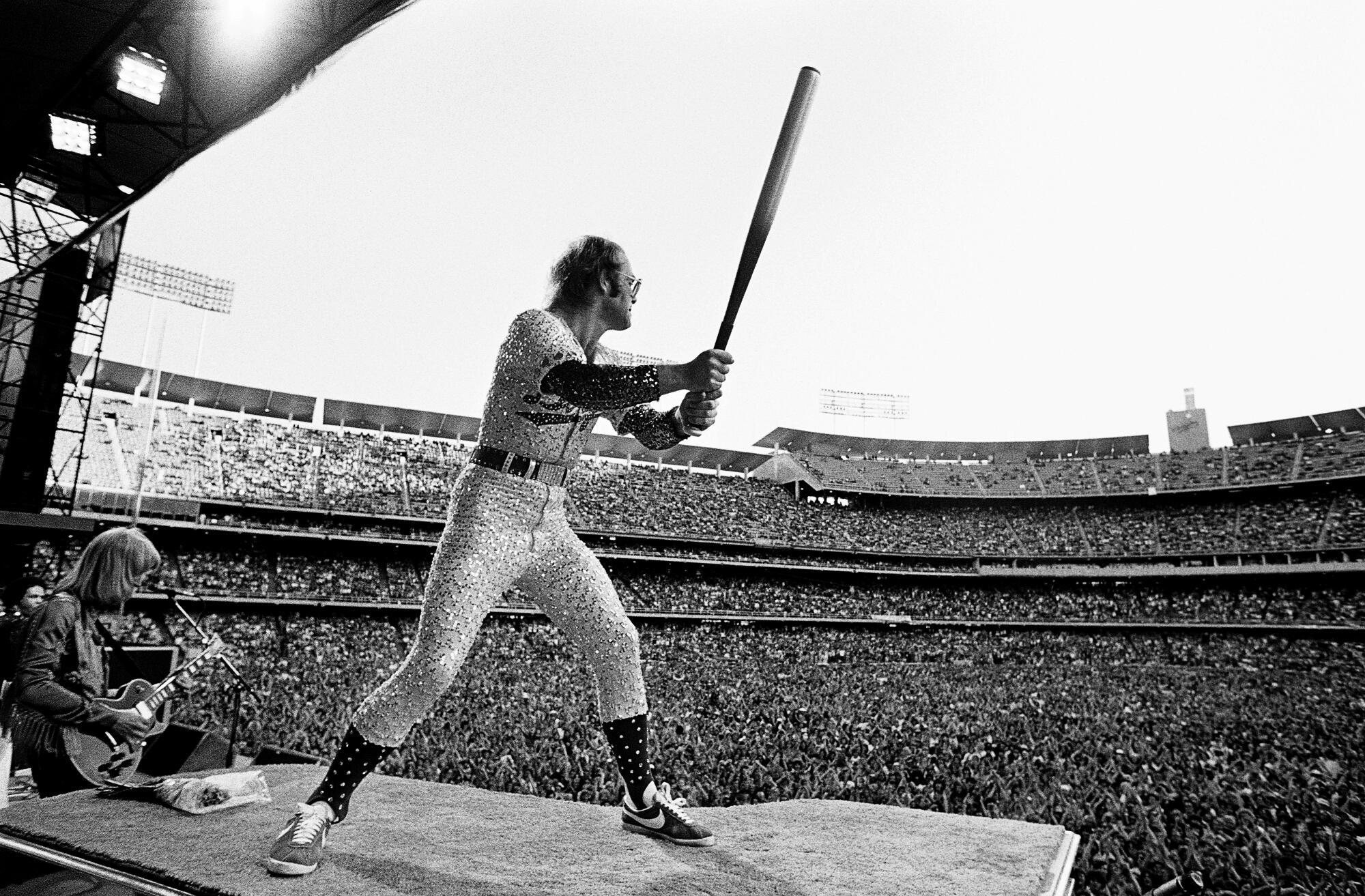
Cidny Bullens was about to go on the road as a backup singer with Bob Dylan’s Rolling Thunder Revue when John asked her to join his tour instead. (Bullens, then Cindy, transitioned in 2011, and uses she/her pronouns to refer to that stage of their career.) “And I picked Elton, because Elton was Elton,” says Bullens. He remembers one moment in particular from the two Dodger Stadium shows. “I believe it was the second day, and we were singing ‘Don’t Let the Sun Go Down on Me.’ The sun was going down behind Dodger Stadium, and we were onstage watching it go down, and everyone in the crowd had their Zippo lighters out. You could feel the hairs go up on everyone’s necks. I’ve done a lot of concerts in 50 years. That was the most profound moment I’ve ever had onstage.” He remembers that “Elton cried after the concert was over. I loved him for that.”
Because Elton was Elton, Dodger Stadium wasn’t just a concert, it was a pageant, a spectacle, a kitchen-sink showbiz extravaganza (all for a $10 general admission ticket). On Oct. 23, John, sporting a lime-green suit and matching bowler hat, had received a star on the Hollywood Walk of Fame. At Dodger Stadium, recalls Taupin, “our security team was dressed in pink satin jumpsuits and feather boas. I strolled around in a white suit with a baseball bat and a can of Coors.” Neck-kerchiefed TV staple Charles Nelson Reilly cavorted backstage.
Over the course of each 3 ½ hour concert, split into two sets, John was joined onstage by the 45-member Rev. James Cleveland Choir and by famed local car dealer Cal Worthington, accompanied by a real-live lion, one of the wild animals featured in his TV commercials. Ever shameless, John changed the “vodka and tonics” from “Goodbye Yellow Brick Road” to “tequila sunrises” as a sop to the locals (and maybe to the Eagles, whose new guitarist, Joe Walsh, opened the show.) And most famously, for the second sets, John came out dressed in a Bob Mackie-designed sequined Dodgers baseball uniform and cap, “ELTON” and the number “1” in Dodger blue on the back. In The Times, Hilburn called the concert “his finest hour here.” “Those are the gigs you live for,” John wrote in “Me.” “It was a pinnacle.”
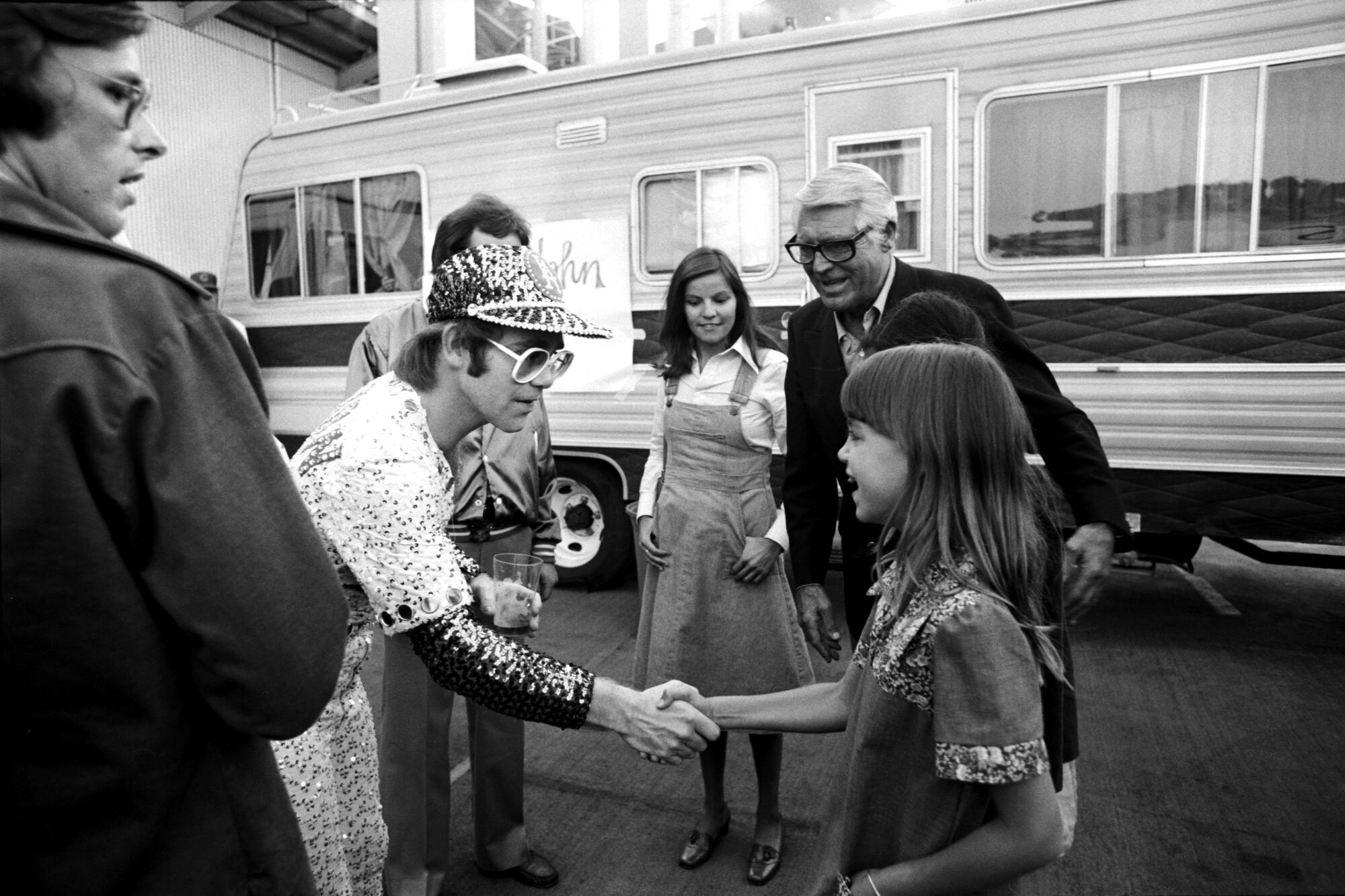
John got his original Dodgers costume back from the Hard Rock Cafe earlier this year, and so, as with Kim Kardashian and Marilyn Monroe’s gown, perhaps a tailor can let it out a skosh (or two) for one quick reprise this week. Meanwhile, guitarist Davey Johnstone and percussionist Ray Cooper will perform alongside Elton as they did in 1975. (Longtime drummer Nigel Olsson is still with John, but wasn’t part of the band in ‘75). And don’t be surprised if Britney Spears, who made her comeback with John’s blessing and tunes on this summer’s Top 10 single “Hold Me Closer,” joins the all-star cavalcade of guests (Dua Lipa, Brandi Carlile, Kiki Dee) for Sunday’s swan song.
King and her wife, Ilana Kloss, have remained close friends with John over the years, absent a five-year period, King says, when John’s addiction-fueled behavior was too much for her to bear. She is now a minority owner of the Los Angeles Dodgers and will be at the shows this week. In 1975, she jumped off John’s piano at Dodger Stadium, at Elton’s behest. When asked if she’d repeat that for the farewell shows, she laughed: “I couldn’t jump over a credit card.” Bullens too is still friends with Elton — he wrote the forward to Bullens’ forthcoming memoir — and will be there on Thursday and Sunday.

Taupin, who took a rare turn onstage in ’75, “banging on a tambourine,” will of course be there, for all three concerts.
“Our relationship with L.A. has always been sacrosanct,” says Taupin, who lives in the Santa Ynez Valley. “It was here we flourished and found our sweet spot. L.A. embraced us before anyone, so we’re indebted. Not sure Elton would agree, but (to quote Grand Funk Railroad), we’re kind of an American Band from L.A.”
When Elton John flew to Los Angeles to make his U.S. debut at the Troubadour on Aug. 25, 1970, the prospect of a visit to America was so tantalizing to his British pals that many accompanied him.
Hilburn has remained a fan of John’s all these years, noting his appreciation for some of John’s more recent albums, including one made in 2010 with Troubadour attendee Russell, and for John’s continued interest in and patronage of up and coming artists. “He’s never lost his love for music,” says Hilburn. “And he’s never lost the longing for that applause.”
As the clock nears midnight on Sunday and John works his way through those classic songs for a final time, he says, “I don’t know how they’re going to get him off that stage.”
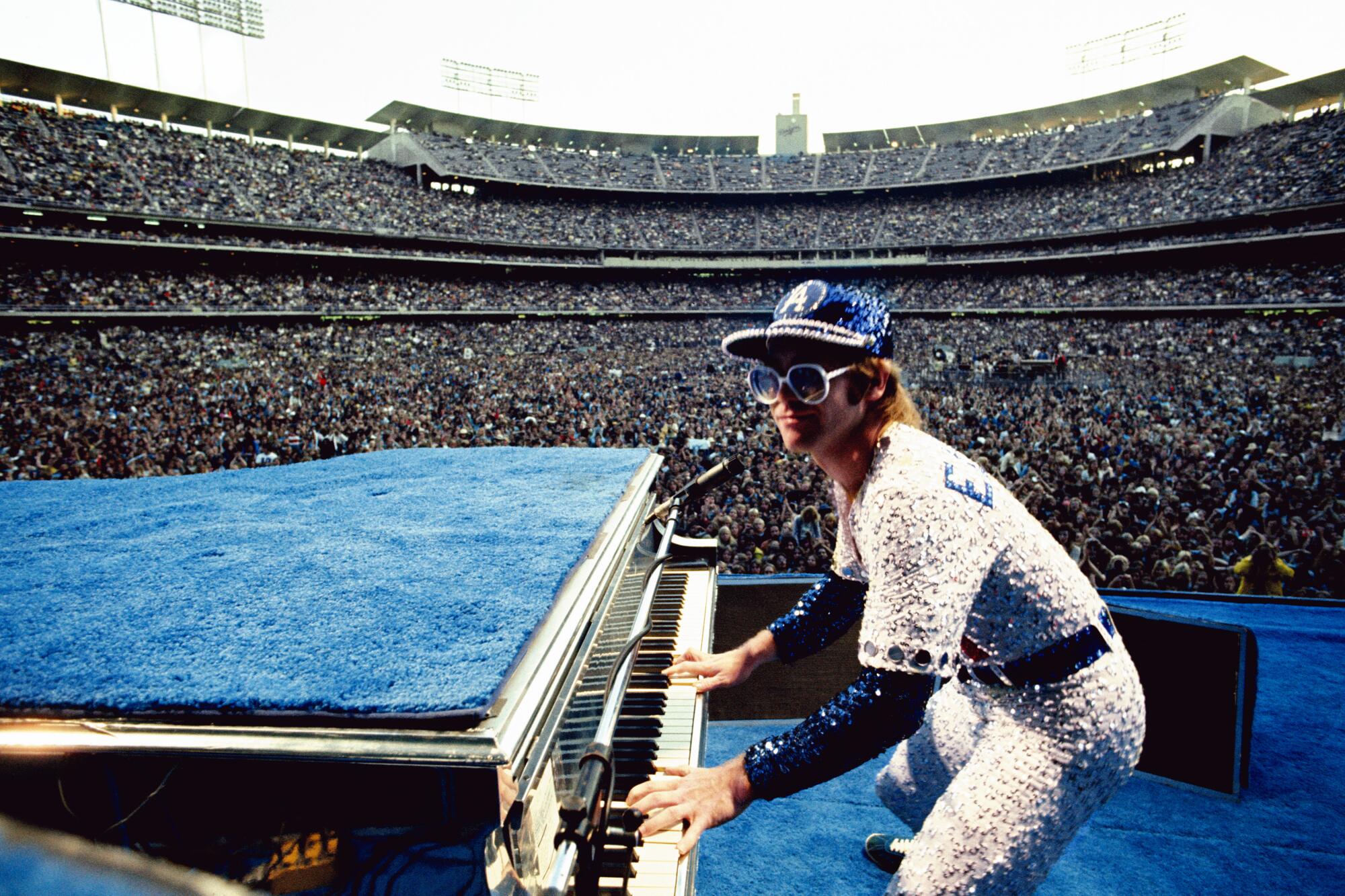
More to Read
The biggest entertainment stories
Get our big stories about Hollywood, film, television, music, arts, culture and more right in your inbox as soon as they publish.
You may occasionally receive promotional content from the Los Angeles Times.
